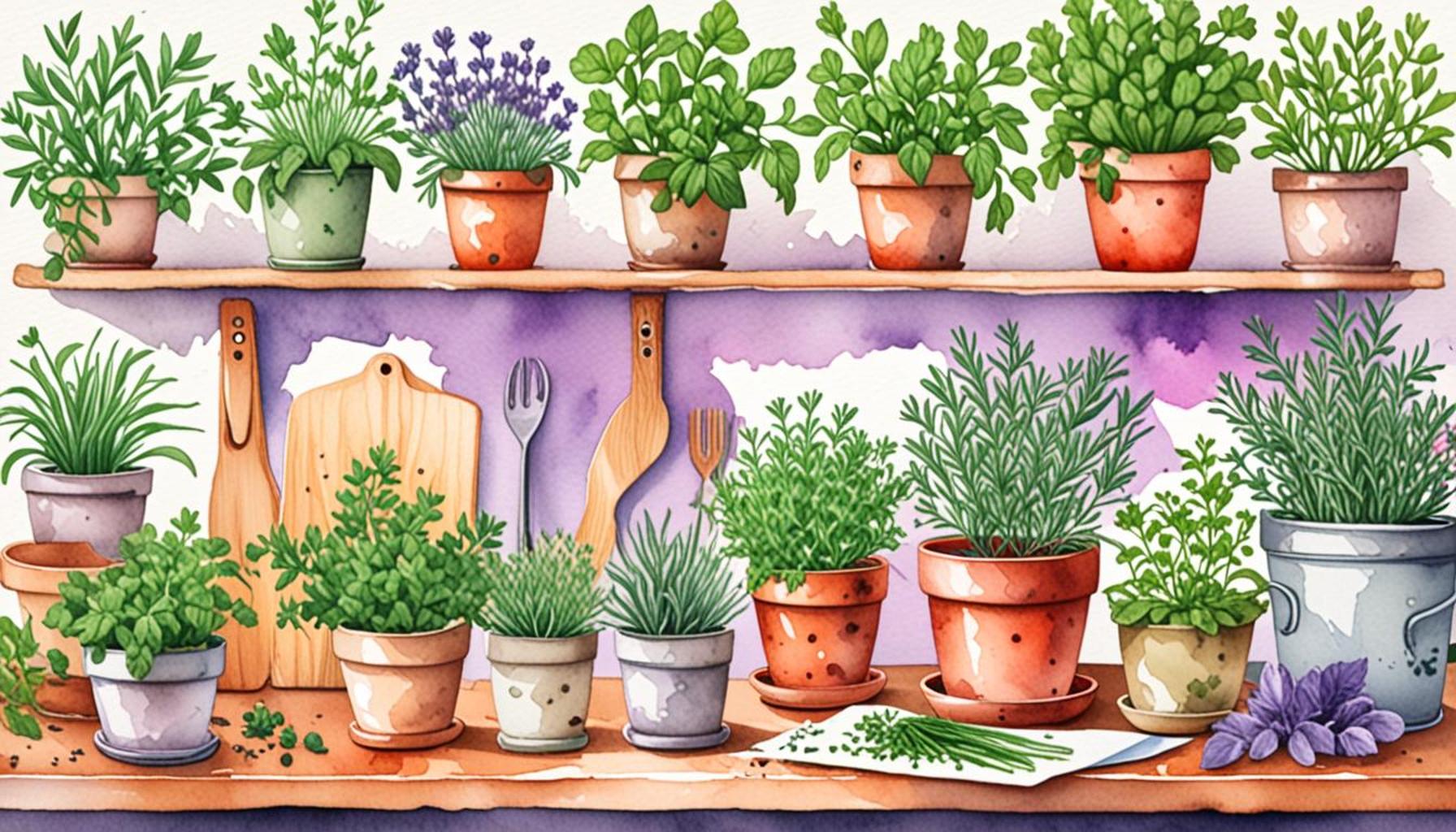How to Select Easy-to-Grow Aromatic Herbs at Home for Beginners

Discover the World of Aromatic Herbs
Learning to grow aromatic herbs at home can be an exciting and rewarding experience. Not only do these herbs enhance your culinary creations, but they also bring a vibrant touch to your living space. For beginners, selecting the right herbs can make all the difference in ensuring success. The beauty of aromatic herbs lies not only in their flavors but also in their versatility, making them a perfect choice for novice gardeners eager to embark on their gardening journey.
Why Grow Aromatic Herbs?
Aromatic herbs are favored for their easy cultivation and multiple uses. Here are some compelling reasons to consider:
- Fresh Flavors: Aromatic herbs like basil, rosemary, and thyme can elevate any dish with their distinctive tastes. Just imagine the joy of adding freshly chopped basil to a homemade pizza or using dill to enhance the flavor of a rich salmon dish.
- Aromatic Scents: Enjoy the delightful fragrances that fill your home. The scent of mint wafting through your kitchen can invigorate the senses, while lavender can create a calming atmosphere, especially during stressful times.
- Health Benefits: Many herbs provide nutritional and medicinal properties. For instance, oregano is known for its antioxidant benefits, while parsley is rich in vitamins A and C. Incorporating these herbs into your diet can not only add flavor but also boost your overall health.
What to Look For in Easy-to-Grow Herbs
For beginners, selecting aromatic herbs that thrive in common environments is key. Consider the following when choosing your herbs:
- Light Requirements: Some herbs need full sun while others prefer partial shade. For example, basil flourishes in bright light, making a sunny windowsill perfect, whereas mint can handle shadier spots.
- Water Needs: Understanding the watering needs helps prevent over or under-watering. Herbs like rosemary prefer drier soil, while basil likes to be kept consistently moist—striking the right balance ensures robust growth.
- Growth Environment: Consider if you’re planting indoors or outdoors for the best results. Many herbs, such as chives and cilantro, thrive in smaller pots and can be grown indoors, making them perfect candidates for kitchen gardening.
In the following sections, we will help you navigate through various popular choices that are perfect for beginners. Starting with hearty options like chives, which are low-maintenance and perfect for adding a mild onion-like flavor, to rosemary, known for its beautiful aromatic needles and resilience, there are countless options awaiting your discovery.
Dive into the captivating world of home gardening and discover how to nurture your aromatic plants with confidence! Whether you are using herbs to enhance flavors in your cooking, crafting herbal teas, or simply adding greenery to your home, the journey of growing aromatic herbs promises not only delicious rewards but also therapeutic benefits that enrich your everyday life.
DIVE DEEPER: Click here for efficient watering tips
Selecting the Right Aromatic Herbs for Beginners
Embarking on your aromatic herb gardening journey can be a delightful pursuit, but selecting the right herbs is crucial for success. For beginners, it’s essential to choose herbs that are not only easy to grow but also versatile in use. Below, we explore some of the best beginner-friendly aromatic herbs and delve into the specific characteristics that make them ideal for novice gardeners.
Top Aromatic Herbs for Beginners
When venturing into the world of aromatic herbs, here are some top selections you should consider:
- Basil: Often regarded as a staple in many kitchens, basil is vibrant and easy to grow. It thrives in warm weather and requires full sun. This herb is a favorite for pesto and enhances various dishes with its strong aroma and flavor. Starting seeds indoors and then transferring them outside after the frost can kickstart your basil garden.
- Mint: A resilient and vigorous grower, mint can thrive in a variety of conditions. It prefers partial shade and moist soil, making it forgiving for those new to gardening. Mint’s refreshing aroma can be used in beverages, desserts, and even savory dishes. Keep in mind that mint spreads quickly, so consider planting it in a pot to control its growth.
- Cilantro: Known for its unique flavor, cilantro is a multifaceted herb used in many cuisines. It grows best in cooler months and can be sown directly into your garden or in pots. Cilantro attracts beneficial insects, which helps encourage a healthy gardening environment. Additionally, the delightful aroma adds freshness to salsas and salads.
- Rosemary: This woody perennial is valued for its aromatic needles and rustic appearance. Rosemary prefers well-drained soil and full sun, making it a perfect herb for containers or in-ground planting. Its evergreen nature offers year-round greenery while its robust flavor enhances roasted meats and vegetables.
- Chives: With a mild onion flavor, chives are incredibly versatile and easy to maintain. They thrive in a variety of conditions, from full sun to partial shade, and require minimal watering once established. Chives not only enhance culinary dishes but also add a lovely visual appeal to gardens with their charming purple flowers.
These herbs serve as excellent entry points for those new to gardening. They are largely forgiving, adapting to various environments and requiring minimal maintenance. When selecting your herbs, consider growing conditions such as light, water, and space availability. Minding these requirements will significantly increase your chances of cultivating a thriving garden.
As you get accustomed to your new role as a herb gardener, remember that exploration is part of the journey. Each herb carries its unique traits and benefits, inviting you to discover how they can enhance your cooking and transform your space. With these easy-to-grow aromatic herbs, you’ll quickly cultivate an enticing garden that is both satisfying and flavorful.
| Herb Type | Growing Benefits |
|---|---|
| Basil | Rich flavor and aroma; grows well in pots. |
| Mint | Highly resilient; thrives in various conditions, perfect for beginners. |
| Chives | Low maintenance; requires minimal watering and care. |
| Rosemary | Perennial herb; offers long-term benefits and requires little water. |
When starting your aromatic herb garden, it’s essential to consider what herbs not only resonate with your culinary preferences but are also easy to grow at home. Each herb has its unique characteristics and advantages, making the selection process both exciting and educational. The above table highlights a few herbs ideal for beginners, showcasing their individual growing benefits.By choosing aromatic herbs that exhibit low-maintenance requirements, you can ensure success in your gardening efforts. Herbs such as basil and mint not only provide a fresh pop of flavor to your dishes, but their growth requires standard conditions, making them accessible even for new gardeners. As you explore and experiment, you’ll discover the joy of nurturing these herbs while enriching your home cooking with incredibly aromatic ingredients. With just a little guidance and dedication, growing aromatic herbs can become an effortless and rewarding hobby.
DISCOVER MORE: Click here to learn about enhancing soil health
Essential Tips for Growing Aromatic Herbs Successfully
Once you have identified the aromatic herbs you want to cultivate, understanding the basic requirements and management techniques is vital to ensuring a successful herb garden. Here are some essential tips to help beginners navigate the growing process and make the most of their chosen plants.
Understanding Growing Conditions
Aromatic herbs generally thrive in bright, sunny locations with good air circulation. Most herbs require at least 6 to 8 hours of sunlight daily to grow healthy and robust. If you’re short on garden space or light, consider utilizing indoors or balcony gardening techniques. You can position your herbs near south-facing windows or even invest in grow lights to provide the necessary light spectrum for photosynthesis.
Soil Selection and Drainage
The type of soil you choose can significantly impact the growth of your herbs. Most herbs prefer well-draining soil rich in organic matter. A good potting mix, possibly combined with compost or perlite, works wonders. For those growing herbs in containers, ensure that pots have ample drainage holes to prevent waterlogging, which can lead to root rot.
Watering Wisely
One of the critical aspects of managing your herb garden is understanding how to water your plants properly. Over-watering is a common mistake among beginners. A good rule of thumb is to check the top inch of the soil. If it feels dry to the touch, it’s time to water. Additionally, herbs such as rosemary and thyme prefer drier conditions, while crops like basil and mint enjoy more moisture. Be attentive to each specific herb’s needs, as this minor adjustment can promote healthier growth.
Well-Timed Harvesting
Harvesting plays an integral role in encouraging growth and preserving the flavor of your herbs. For most aromatic herbs, it’s advisable to begin harvesting once the plants have established a robust structure and have reached a height of at least 6 inches. Regular pruning will not only yield fresh ingredients for your culinary endeavors but will also stimulate bushier growth. Remember to use clean, sharp scissors or garden shears to prevent any damage to the plant.
Pest Management and Care
Every gardener fears pests, but the good news is that many aromatic herbs possess natural pest-repelling properties. Growing herbs like rosemary and mint can keep annoying insects like aphids and mosquitoes at bay. However, should you encounter an infestation, non-toxic methods such as insecticidal soap or neem oil provide effective solutions without harmful chemicals. Regularly inspecting your plants will ensure any issues are addressed promptly.
Expanding Your Herb Garden
Once you feel comfortable with your initial selections, consider diversifying your garden by adding more aromatic herbs. Options like thyme, oregano, and sage may offer new dimensions to both your garden and your culinary repertoire. Keep in mind the unique conditions and care each herb requires to thrive.
In summary, by understanding the individual needs of your aromatic herbs and incorporating proper care practices, beginners can enjoy a flourishing garden that not only beautifies outdoor spaces but also enriches everyday dishes. As you continue to learn, feel free to experiment with new herbs and techniques, allowing various flavors and aromas to flourish right in your home.
LEARN MORE: Click here for more insights
Conclusion: Cultivating Your Aromatic Herb Garden
Starting your journey into the world of aromatic herbs as a beginner is not just a rewarding endeavor but also a gateway to enhancing your culinary experiences. By selecting herbs that are easy to grow, such as basil, mint, and parsley, you create an opportunity to connect with nature while enjoying fresh, flavorful ingredients right from your own home. Understanding the basic requirements, from sunlight to soil drainage and proper watering, can dramatically increase your chances of success in this flavorful pursuit.
As you embark on your gardening adventure, remember that patience and observation are key. Each herb has its own unique characteristics and growth patterns, which means that some herbs may thrive more quickly than others. Through hands-on experience, you will learn to adjust your techniques, make informed decisions, and even expand your garden to include a variety of aromatic delights like thyme and oregano.
Moreover, cultivating aromatic herbs not only beautifies your living space but also promotes wellness and sustainability. With the ability to ward off pests naturally and enhance the flavors of your meals, these herbs are invaluable. So, gather your pots, soil, and seeds, and let your aromatic herb garden flourish. The flavors, smells, and health benefits await—take the first step and dive into this aromatic adventure today!


